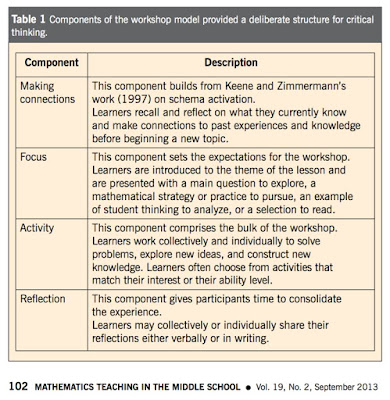Recently, I have been considering how to apply principles from Design Thinking to education. For example, I think creating lesson prototypes instead of lesson plans can help teachers in several ways.
 |
| d.school |
- We make prototypes faster than plans, which means more time for other teachery-things;
- Because less time is spent developing a lesson prototype, the teacher is usually less invested in sticking to it when things go poorly;
- Multiple prototypes are often made, so if the teacher wants to shift gears, there's another idea available; and
- A prototype has more blank-space (less teacher control), which leaves more room for interesting interpretations of the lesson by students.
When it came time to develop a framework for the lesson prototype, I returned to a familiar instructional approach: Math Workshop. I wrote about this approach with some GVSU math colleagues in a Mathematics in the Middle School article. Table 1 from the article, shown below, gives a good overview of the Math Workshop Model that we use.
I tend to use "Schema activation" instead of "Making connections" for the first part of the lesson because of its use in reading workshop - where I was introduced to the approach.
Last year, I shared this method with Kristin Frang. We were working on a project that required designing lessons. I wrote the framework on the board using only the initials:
Kristin said, "If only you had an "I" it could be safari."
 Having been on an actual safari (and being a bit obsessive about acronyms), I couldn't believe I had never seen this before. All the framework needed was an "I" to complete the word, safari.
Having been on an actual safari (and being a bit obsessive about acronyms), I couldn't believe I had never seen this before. All the framework needed was an "I" to complete the word, safari.
The "I" became "I want to ..." as a way to recognize the importance of students making their own choice about what to explore in their learning journey. And that's the coolest thing about SAFARI lesson design - in Swahili, safari literally means travel or journey.
With the framework developed, the next thing to do was create a process for using the framework to design the lesson prototypes. I wanted to stay true to Design Thinking and use a process that would foster innovation. So in the next post, we will explore Carousel Lesson Design.


No comments:
Post a Comment